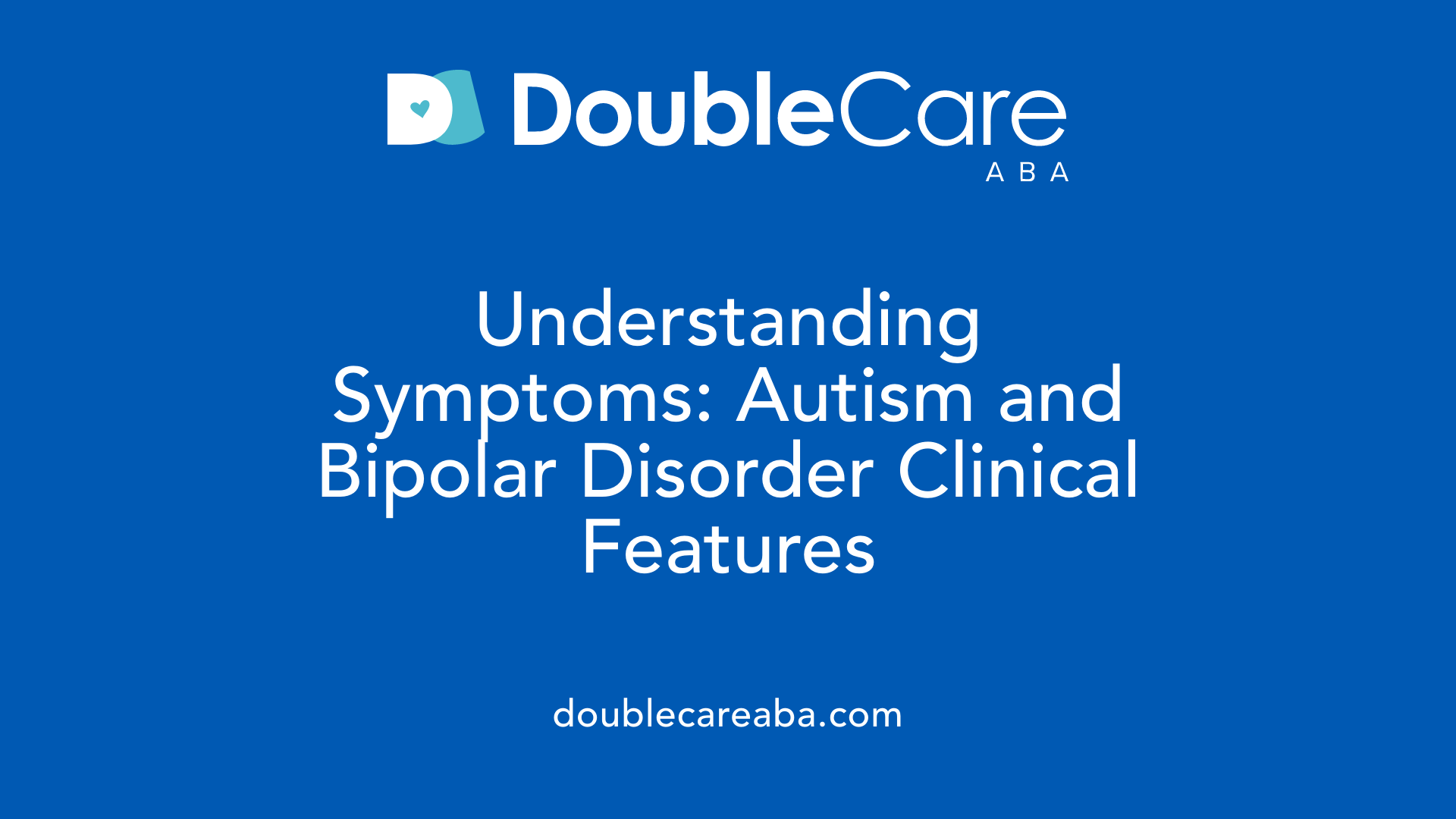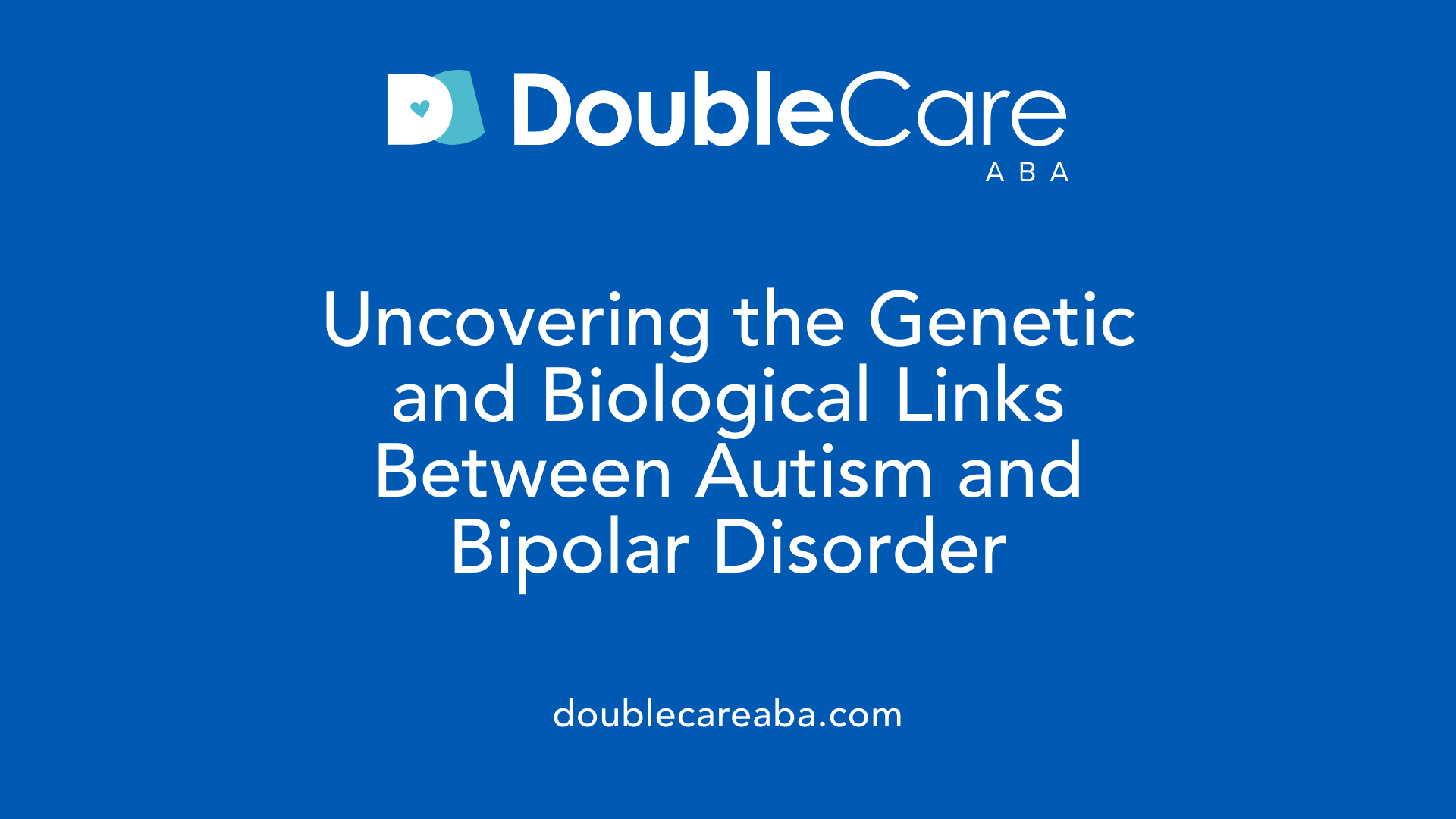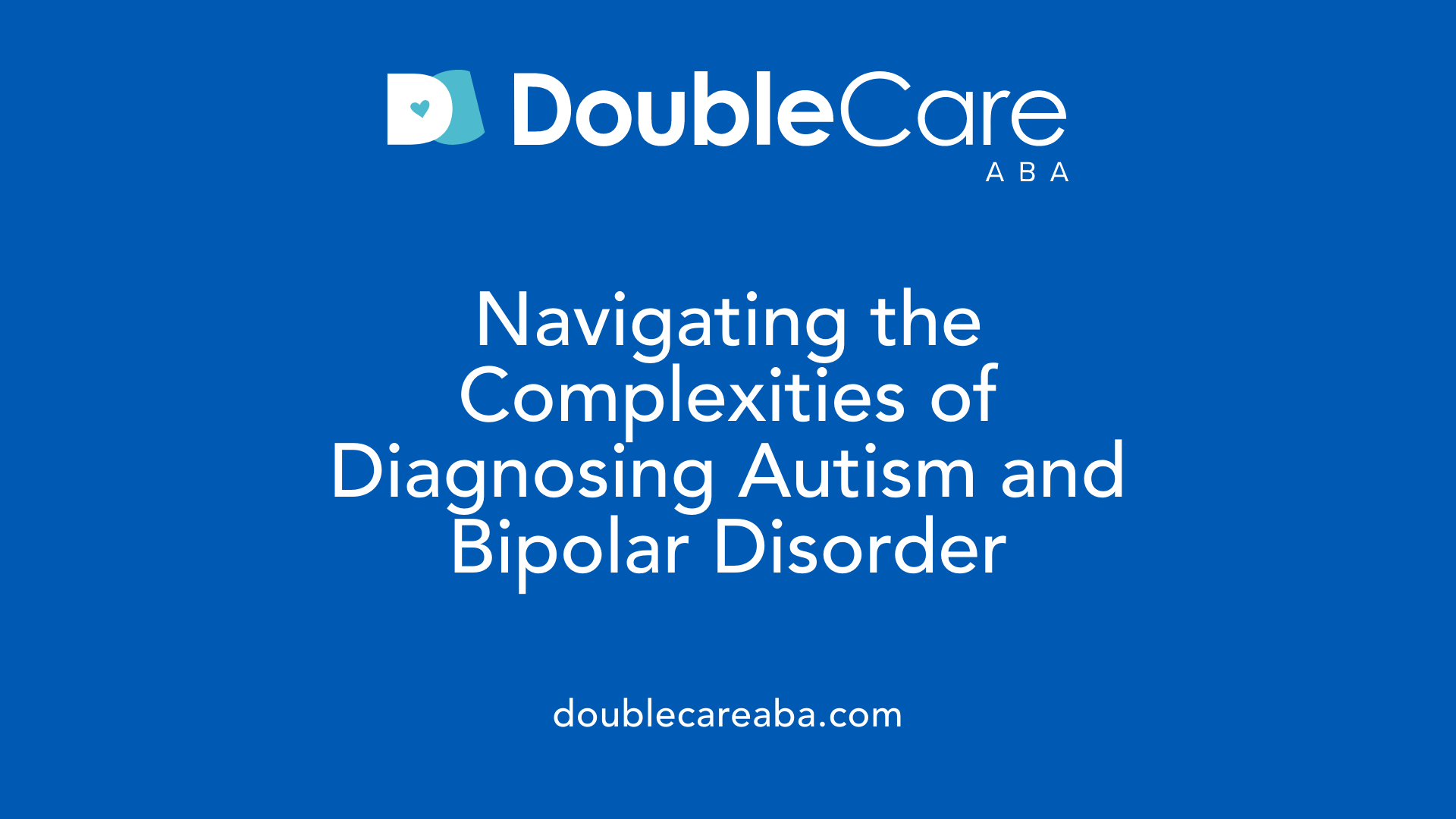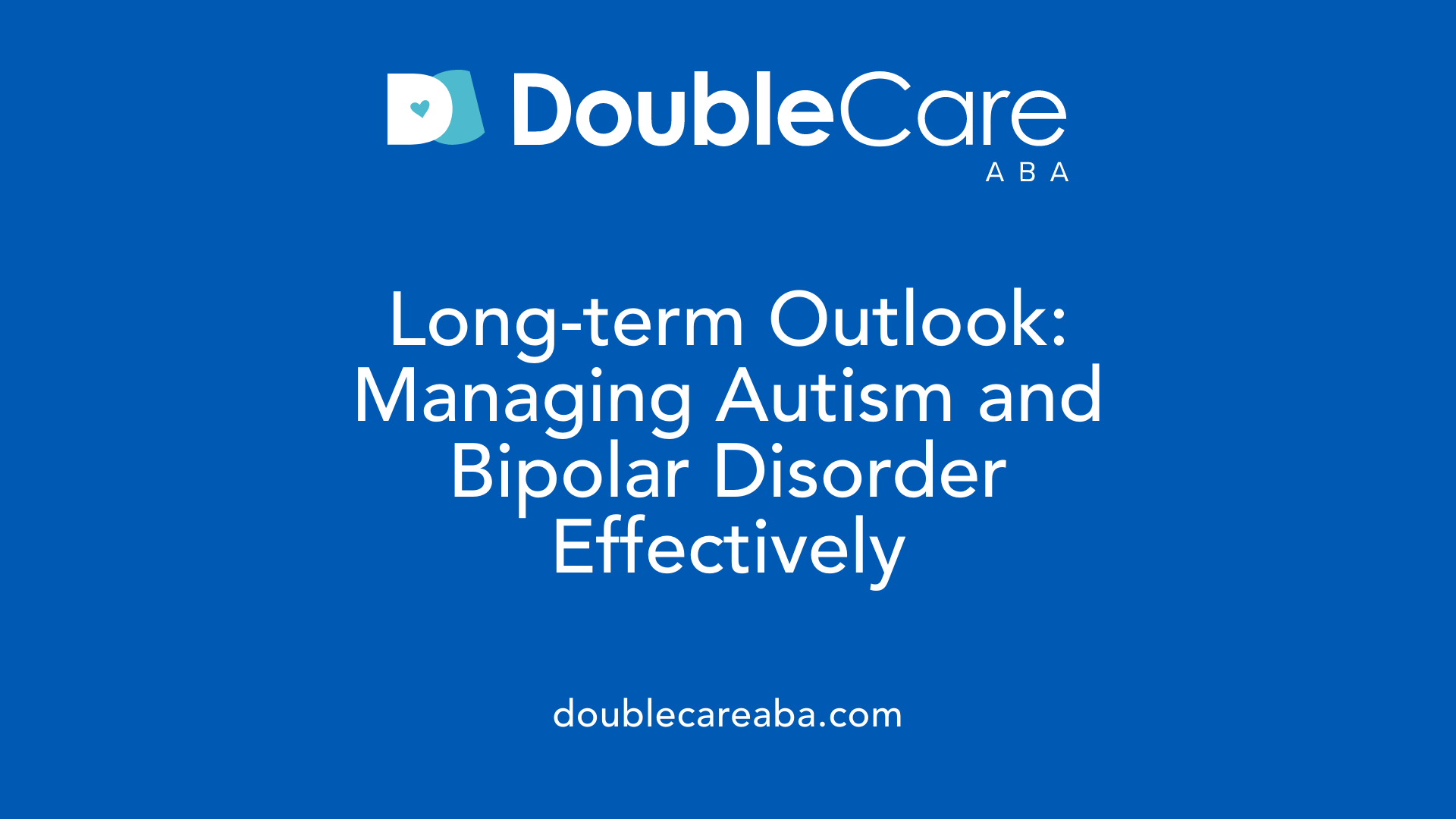Understanding the Intersection of Autism and Mood Disorders
Autism spectrum disorder (ASD) and bipolar disorder are distinct neuropsychiatric conditions, yet emerging research indicates a notable overlap, particularly in diagnosed populations. This article explores the symptoms, prevalence, biochemical underpinnings, diagnostic challenges, and treatment approaches for individuals experiencing both autism and bipolar disorder, emphasizing the importance of early detection and tailored care.
Symptomatology and Clinical Presentations of Autism and Bipolar Disorder

What are the typical symptoms and clinical presentations of autism and bipolar disorder?
Autism spectrum disorder (ASD) is primarily characterized by challenges in social communication, difficulty forming and maintaining relationships, and restricted or repetitive behaviors. Individuals with autism often display intense focus on specific interests, unusual responses to sensory stimuli, and rigid adherence to routines. Common behavioral traits include hyperactivity, sleep disturbances, irritability, and impulsivity, which can significantly impact daily functioning.
Bipolar disorder, on the other hand, involves dramatic mood swings that include manic and depressive episodes. During manic episodes, individuals may experience elevated mood, a surge of energy, rapid speech, decreased need for sleep, impulsivity, risky behaviors, and heightened irritability. Depressive episodes involve feelings of sadness, fatigue, loss of interest or pleasure, changes in appetite, difficulties with concentration, and sometimes thoughts of self-harm. These shifts can disrupt an individual's ability to function and often lead to significant distress.
Overlap and differences in symptoms when conditions co-occur
When autism and bipolar disorder co-exist, distinguishing between symptoms becomes challenging due to the overlap in behavioral manifestations. For example, rapid speech, irritability, and agitation are common in both conditions. Individuals with autism may already exhibit repetitive behaviors and hyperactivity, which can mask or mimic manic episodes.
In cases of co-occurrence, manic or depressive episodes may present earlier, sometimes as young as childhood or adolescence. A vital part of differentiating true mood episodes involves analyzing the symptom patterns over time, their cyclicity, and the context. Sudden changes, such as an increase in energy, pacing, reduced sleep, or impulsive actions, especially when they differ from the person's baseline behaviors, may signal a mania.
The presence of mood instability, increased irritability, racing thoughts, social withdrawal, and low reactivity to negative events can appear alongside core autistic features but require careful clinical assessment. Since communication challenges are common in autism, obtaining a reliable history and distinguishing between developmental behaviors and mood episodes is essential.
Treatment implications
Treating co-occurring autism and bipolar disorder involves a nuanced approach. Mood stabilizers such as valproic acid, lithium, and antipsychotics like risperidone or aripiprazole are often used. It's important for clinicians experienced with autism to carefully monitor medication effects due to possible side effects.
Psychotherapeutic interventions, including cognitive-behavioral therapy (CBT), can also support mood regulation, but therapies should be adapted to individual communication and cognitive needs.
Ultimately, a thorough assessment by specialists is necessary to correctly identify symptoms, differentiate between overlapping features, and develop an effective, personalized treatment plan.
Prevalence, Risk Factors, and Epidemiological Insights
How prevalent is the co-occurrence of autism and bipolar disorder, and what are the associated risk factors?
Research shows that autism and bipolar disorder often co-exist more frequently than in the neurotypical population. While the overall prevalence of bipolar disorder in the general population is around 4%, studies estimate that about 5% to 8% of autistic individuals also have bipolar disorder. More recent research suggests that the rate may be as high as 27% in certain groups of autistic children exhibiting bipolar symptoms, and approximately 7.5% in autistic adults.
The co-occurrence of these conditions is influenced by several factors. Age plays a significant role, with adults with autism being more susceptible; nearly 10% of autistic adults experience bipolar disorder, compared to a much lower rate in children. This suggests that bipolar symptoms may develop or become more noticeable later in life.
Gender differences are also notable. Females with autism are more likely to experience co-occurring bipolar disorder, whereas males with autism tend to have higher rates of psychosis instead. These variations highlight the importance of gender-sensitive assessment and treatment approaches.
Genetics are a major contributor. There is evidence for shared genetic factors, with some genes linked to both autism and bipolar disorder. A family history of mood disorders often increases the likelihood of developing both conditions, emphasizing the role of inherited predispositions.
Environmental factors and early developmental influences also add to the risk profile. Adverse life experiences, prenatal conditions, and early brain development contribute to the increased vulnerability.
Overall, the heightened prevalence in autistic populations underscores the importance of vigilant screening and ongoing assessment. Proper diagnosis can be challenging due to overlapping symptoms but is critical for effective treatment and management.
Key Data Summary
| Prevalence Rate in Autism | General Population Rate | Notes |
|---|---|---|
| 5-8% | 4% | Based on recent studies |
| Up to 27% in certain cohorts | 1% in youth | Higher in children and adults |
| 9.4% of autistic adults experience psychosis | Higher risk for comorbid conditions |
Factors Influencing Co-occurrence
| Factor | Impact | Additional Details |
|---|---|---|
| Age | Increased risk in adulthood | Bipolar symptoms tend to emerge or become more evident later in life |
| Gender | Females more prone to bipolar | Males more prone to psychosis in autism |
| Genetics | Shared gene patterns | Family history increases risk |
| Environmental | Early development influences | Prenatal and life experiences can affect risk |
Understanding these factors can aid clinicians in early detection and personalized intervention strategies, ultimately improving outcomes for individuals facing both autism and bipolar disorder.
Genetic and Biological Underpinnings Linking Autism and Bipolar Disorder

Are there genetic or biological factors that link autism and bipolar disorder?
Research increasingly supports the existence of genetic and biological links between autism spectrum disorder (ASD) and bipolar disorder (BD). These connections are rooted in shared heritable components and overlapping genetic variants that influence neurodevelopment.
One of the primary areas of focus involves genes related to synaptic function. Variants in genes coding for synaptic proteins—such as neurexins, neuroligins, and calcium channels like CACNA1C—have been implicated in both conditions. These proteins are crucial for synapse formation, neuroplasticity, and overall communication between neurons. Disruptions here can lead to difficulties in brain development and functioning seen in both autism and bipolar disorder.
Genetic studies also highlight the role of copy number variations (CNVs) and single-nucleotide polymorphisms (SNPs). These small genetic changes can have significant impacts and are often found in individuals diagnosed with either or both conditions. For example, certain CNVs are linked to increased risk for neuropsychiatric disorders, including autism and bipolar disorder, suggesting these shared genetic alterations might influence similar pathways.
Further evidence comes from research on de novo mutations, which are new genetic alterations not inherited from parents. These mutations often affect genes involved in neural development and are associated with both conditions. This indicates a shared pathogenic mechanism at the molecular level.
Neurobiological pathways involved in both disorders involve disruptions in neural circuits that regulate mood, behavior, and cognition. Abnormalities in pathways governing neuroplasticity, synaptic transmission, and calcium signaling have been identified, highlighting common biological frameworks.
Genetic studies and implications for understanding comorbidity
Genetic investigations reveal that individuals with autism who develop bipolar symptoms often carry specific genetic markers linked to synaptic regulation and neural connectivity. The presence of these shared genetic factors increases the understanding of why these disorders can co-occur and assists in developing targeted treatment strategies.
Implications of these findings emphasize the importance of a genetic and neurobiological perspective when diagnosing and treating comorbid autism and bipolar disorder. Recognizing shared pathways may lead to more precise interventions, potentially addressing underlying causes rather than just symptoms.
In summary, the overlap of genetic loci, mutations, and disrupted neurobiological pathways demonstrates a biological basis for the co-occurrence of autism and bipolar disorder. Continued research in this area is crucial for unlocking more effective treatments and improving prognosis for affected individuals.
Below is a table summarizing genetic factors, pathways involved, and their relevance:
| Genetic Factors | Neurobiological Pathways | Implications for Comorbidity |
|---|---|---|
| Shared gene mutations (e.g., neurexins, neuroligins) | Synaptic development and plasticity | Explains overlapping symptoms and co-occurrence |
| Copy number variations (CNVs) | Neural connectivity and signaling | Suggests common developmental disruptions |
| Single-nucleotide polymorphisms (SNPs) | Calcium signaling and neuroplasticity | Highlights shared genetic risks affecting mental health pathways |
| De novo mutations | Brain circuit regulation | Indicates potential targets for diagnostics and therapies |
Understanding these genetic and biological underpinnings provides insights into why autism and bipolar disorder are interconnected. This knowledge guides future research aimed at refining diagnostic criteria and developing personalized treatments.
Diagnostic Challenges and Considerations in Co-occurring Conditions

What challenges exist in diagnosing individuals with both autism and bipolar disorder?
Diagnosing individuals with both autism spectrum disorder (ASD) and bipolar disorder is a complex process fraught with difficulties. One of the primary challenges arises from the significant overlap in symptoms shared by both conditions. For example, behaviors such as irritability, mood swings, hyperactivity, impulsivity, and sleep disturbances are common in both autism and bipolar disorder. These overlapping symptoms can make it difficult to determine whether mood episodes are part of bipolar disorder or simply reflective of ASD traits.
Moreover, the typical developmental trajectories of these disorders add to the complexity. Autism usually manifests early in childhood, with evident social communication difficulties and repetitive behaviors. In contrast, bipolar disorder might develop later, often during adolescence or early adulthood, with mood episodes that are episodic and fluctuate over time.
Communication difficulties characteristic of autism can further obscure the diagnosis. Limited expressive language or atypical communication styles may hinder a thorough clinical assessment, making it harder for clinicians to accurately identify mood episodes or distinguish them from autistic behaviors.
Genetic and neurobiological studies suggest a potential shared biological basis, with some genes linked to both conditions. This overlap increases the likelihood that both disorders may co-occur, but it also complicates the diagnosis, as symptoms are intertwined and not mutually exclusive.
To address these challenges, clinicians emphasize the importance of using detailed developmental histories. Gathering information about the onset, duration, and severity of symptoms over time helps differentiate what might be related to ASD versus bipolar disorder.
Additionally, spectrum-based diagnostic tools and assessment strategies are invaluable. These tools recognize the wide range of symptom presentations and developmental variations, aiding clinicians in making nuanced diagnoses rather than relying solely on traditional criteria.
Ongoing monitoring and longitudinal assessment are essential. Mood disorders can evolve over time, and recognizing early signs of bipolar episodes requires careful observation of changes in mood, behavior, sleep, and activity levels.
In conclusion, accurately diagnosing co-occurring autism and bipolar disorder demands a comprehensive approach. It involves meticulous clinical evaluation, consideration of individual developmental history, utilization of spectrum-informed assessment methods, and continuous follow-up to ensure correct diagnosis and effective treatment planning.
Treatment Strategies and Management Approaches
What treatment options and management strategies are effective for individuals diagnosed with both autism and bipolar disorder?
Addressing bipolar disorder in individuals with autism spectrum disorder (ASD) necessitates a comprehensive, multidisciplinary treatment plan. Since both conditions can have overlapping symptoms and unique presentation challenges, tailored approaches are essential for effective management.
Pharmacological options for treating bipolar disorder in autistic individuals typically include mood stabilizers such as valproic acid and lithium. Valproic acid is often favored because it can stabilize mood swings and reduce manic episodes, but it requires careful monitoring due to potential side effects like liver issues and weight gain. Lithium, a classic mood stabilizer, can be effective but must be used cautiously because of its narrow therapeutic window and possible communication challenges in autistic individuals.
In addition to mood stabilizers, atypical antipsychotics such as risperidone and aripiprazole are frequently prescribed. These medications are especially useful in managing irritability, hyperactivity, and certain mood symptoms associated with bipolar disorder. Both risperidone and aripiprazole are FDA-approved for irritability in children with autism, but they require close supervision to monitor side effects like weight gain, sedation, and metabolic changes.
Behavioral therapies adapted for ASD are crucial. Cognitive-behavioral therapy (CBT) can help individuals recognize and regulate mood swings, develop coping skills, and improve emotional regulation. Family education and therapy support caregivers in managing symptoms and creating a stable environment. In some cases, innovative therapies such as ketamine-assisted psychotherapy are explored, though these are typically experimental and require specialist oversight.
Non-pharmacologic strategies also play a significant role. Maintaining a consistent daily routine, practicing good sleep hygiene, engaging in regular physical activity, and stress management techniques can help stabilize mood and reduce triggers for episodes. Lifestyle modifications and environmental adjustments tailored to the individual’s needs support overall well-being.
Given the complex symptomatology and potential sensitivities, treatment planning should involve close collaboration with psychiatrists, psychologists, and other healthcare professionals experienced in both autism and mood disorders. Regular assessment and monitoring are vital to adjust treatments and minimize adverse effects, thereby optimizing outcomes.
In summary, effective management necessitates an integrated approach combining medication, psychotherapy, and lifestyle strategies, always customized to the individual’s unique profile to foster stability and improve quality of life.
Long-term Outcomes and Prognosis for Co-occurring Autism and Bipolar Disorder

What is the prognosis and long-term outlook for individuals with both autism and bipolar disorder?
The outlook for people who have both autism spectrum disorder (ASD) and bipolar disorder varies considerably. It depends on factors such as how severe each condition is, how early they are diagnosed, and the kind of treatment and support they receive. Early detection and proper management can significantly improve both functioning and quality of life.
Individuals with autism who also have bipolar disorder often experience complex and early-onset mood episodes. The mood swings, whether manic or depressive, may be more intense or mixed, with some showing rapid shifts similar to their autism-related behaviors. This overlap can make it difficult for clinicians to distinguish bipolar episodes from typical ASD traits, leading to potential delays in proper treatment.
Despite these challenges, some individuals can achieve stability over time. Access to comprehensive treatment—combining medication, therapy, and ongoing support—plays a crucial role in managing symptoms effectively.
Studies indicate that with appropriate interventions, many autistic people with bipolar disorder can experience periods of remission. Medications like mood stabilizers (such as valproic acid and lithium) and atypical antipsychotics (such as risperidone and aripiprazole) are often used. Psychological therapies, including cognitive-behavioral therapy (CBT), can also help manage mood cycles.
However, the trajectory of bipolar disorder in autistic individuals can include recurrent episodes affecting their social interactions, everyday functioning, and mental health. These challenges are compounded by the core autism symptoms, like difficulties with communication and social engagement.
Long-term management requires an ongoing, proactive approach. Support systems including family, community programs, and mental health services are essential for maintaining stability and supporting independence.
Impact of early diagnosis and intervention
Early diagnosis plays a pivotal role in improving long-term outcomes. When bipolar symptoms are recognized early—before they lead to severe episodes—interventions can be more effective. Initiating treatment during childhood or adolescence helps prevent the escalation of symptoms and reduces the risk of developing secondary issues like depression, anxiety, or risky behaviors.
Prompt intervention also allows for the development of tailored strategies suited to the individual’s needs, which can include medication adjustments, behavioral therapies, and social skills training. Regular monitoring helps identify emerging symptoms before they become debilitating.
Potential for stability and episodic nature of mood symptoms
Bipolar disorder is characterized by episodic mood changes. In many cases, with sustained treatment, a person can experience longer periods of stability between episodes. The goal of treatment is to minimize the frequency and severity of these episodes, enabling better social participation and daily functioning.
It is important to recognize, however, that some individuals may continue to experience mood fluctuations despite ongoing therapy. The episodic nature of bipolar disorder means that fluctuations are often a part of the long-term course, necessitating constant adjustment of treatments and coping strategies.
Importance of support systems and ongoing monitoring
Support networks are vital for long-term success. Family, peers, educators, and clinicians all contribute to creating a stable environment that promotes mental health. Structured routines, predictable environments, and behavioral support can help manage both ASD and bipolar symptoms.
Ongoing psychiatric monitoring helps in catching early signs of mood episodes or autism-related difficulties. Regular check-ins allow healthcare providers to tweak medications and therapies as needed. This continuous oversight helps reduce hospitalization risks and improves overall well-being.
In summary, the prognosis for individuals with autism and bipolar disorder hinges on early, accurate diagnosis, personalized treatment, and robust support systems. While the condition presents unique challenges, many individuals can enjoy meaningful, productive lives with comprehensive care, ongoing monitoring, and community involvement.
| Aspect | Influence on Long-term Outcomes | Additional Notes |
|---|---|---|
| Early diagnosis | Improves prognosis | Leads to timely treatment and better symptom management |
| Treatment consistency | Enhances stability | Involves medication, therapy, and support systems |
| Support networks | Critical for stability | Family, community, and mental health services play essential roles |
| Symptom management | Reduces episodes | Focused on mood stabilization and behavioral strategies |
| Ongoing monitoring | Prevents relapse | Regular psychiatric assessments for medication adjustments |
| Individual factors | Lead to variability | Severity, age of onset, co-occurring conditions influence long-term outlook |
Understanding and addressing these aspects collectively can motivate hope and improve the quality of life for those managing both autism and bipolar disorder.
Integrating Care for Better Outcomes
The intersection of autism spectrum disorder and bipolar disorder presents unique challenges that require nuanced diagnosis and personalized treatment strategies. Recognizing overlapping symptoms, understanding the genetic and neurobiological links, and implementing comprehensive management plans can significantly improve quality of life for affected individuals. Continued research into shared pathways and therapeutic approaches holds promise for more effective interventions and better long-term outcomes, emphasizing the importance of multidisciplinary collaboration and ongoing assessment.
References
- Autism and Bipolar disorder
- Bipolar disorder - National Autistic Society
- Bipolar Disorder and ASD - Massachusetts General Hospital
- Autism and the Risk of Bipolar Disorder
- Occurrence of psychosis and bipolar disorder in adults with autism
- Navigating the intersection between autism spectrum disorderr and ...
- Understanding Autism and Bipolar Disorder - Verywell Mind
- Longitudinal Course of Bipolar Disorder in Youth With High ...















